Wall finishes in the kitchen

The kitchen is a multifunctional room for which it is important to choose the right wall decoration. Due to the preparation of food, "difficult" conditions are often observed here - high air humidity, soot, fumes, grease splashes. All this must be sustained by the decor of the wall surface. Therefore, deciding to make repairs, one should give preference not only to aesthetic materials, but also to practical ones. Let's talk about what types of finishes are best for the kitchen.
What can be pasted over?
There are many materials on the construction market for finishing kitchen walls. They all have their own advantages and disadvantages. To figure out which type of finish to give preference to, you need to study their performance and features.

Wallpaper
This material is often chosen to give walls an aesthetic appearance. The popularity is due to the rich assortment of this finish and its extensive price range. Various types of wallpapers for every taste and wallet are presented on the windows, making it easy to make a choice. However, when buying, it is important to take into account a few nuances, since not all wallpapers are suitable for the kitchen.
It is best to refuse decor with a paper base. Such wallpaper will quickly get dirty in the kitchen and will require new cosmetic repairs. Experts advise giving preference to washable materials. They can be easily removed from grease stains, water splashes and other contaminants.
Just do not confuse washable wallpaper with moisture resistant. The former can easily return aesthetics with damp rags and specialized products, while the latter cannot be washed.


The following types of wallpaper will be a practical solution for the kitchen.
- Non-woven. The material is not afraid of water and is able to "breathe". The latter property is also important, since it provides good air microcirculation, which prevents the formation of mold and various types of fungus.
- Vinyl. There are several types of vinyl wallpaper on the market. It is a foamed, smooth and hard vinyl, silk screen printing. Not all of the finishes presented are suitable for the kitchen. For example, foamed vinyl will lose its aesthetics at high humidity, so you should refuse to buy it. Vinyl wallpapers are beautiful, practical and durable, but they also have a significant drawback - the inability to let air through. Because of this feature, there are high risks of mold when gluing vinyl material in a room with high humidity. To avoid this nuisance, the wall should be treated with an antiseptic solution before wallpapering.
- Glass fiber. This material is often purchased for subsequent coloring (depending on the manufacturer, it can withstand up to 15 colors).
- Cork. Durable and practical wallpaper with a service life of about 20 years. They easily tolerate temperature extremes, high humidity. They can be washed or rubbed without fear of damage to their appearance. The disadvantages of cork finishing include high cost, uniformity of design and color schemes.




From the presented list, non-woven wallpaper occupies the leading positions in sales. On their surface, various prints, geometric patterns, dishes, fruits, various exotic ornaments can be depicted, in addition, some models imitate natural materials. The choice of shades is also great - from light to dark and bright "flashy". Rich colors and different designs will allow you to choose wallpaper for any style of interiors.


Oilcloth
Decorating kitchen walls with oilcloth is an old method that has lost its relevance over the years. It was often preferred in Soviet times, when the market was "poor" for materials for internal cosmetic repairs. However, even today some owners of apartments and private houses prefer oilcloth when decorating their kitchens. These are mainly those who cannot afford to pay for expensive materials.


Oilcloth as a decoration for kitchen walls has the following advantages:
- does not absorb moisture;
- has vapor resistance;
- does not absorb various types of dirt;
- easy to clean with water using non-abrasive detergents;
- is inexpensive, especially when compared with other types of materials.
A rich assortment of colors makes it possible to choose an oilcloth in accordance with your requirements for the appearance of the finish.


This material also has disadvantages. For example, it does not allow air to pass through, which means that microorganisms hazardous to health can start under it. Another disadvantage is the low quality of the products. When exposed to humidity and high temperatures, the paints on the oilcloth gradually fade and fade, and the image begins to wear off. These shortcomings are not a reason to refuse to purchase a product. The main thing is to choose the highest quality materials. Those will have a clear pattern, not emit an unpleasant odor, and have sufficient strength.

Sheathing
Kitchen walls can be not only pasted over, but also sheathed. For these purposes, several types of materials are sold, both natural and artificial. The first ones are environmentally friendly, excellent decorativeness and durability, but at the same time they are expensive. Artificial cladding is not so durable, it interferes with natural microcirculation of air, but it is more affordable financially. Let's consider in more detail how walls can be sheathed.

Parquet board
This method of cladding is one of the most popular trends in the design of kitchen interiors. A parquet board is a plank (the values of length, width and thickness may vary), the inner two layers of which are often made of pine needles, and the decorative one is made of valuable wood. In order to increase resistance to abrasion and mechanical damage, the surface of the strips is covered with a specialized protective layer. These can be various oil mixtures, varnishing compositions.


As a cladding for kitchen walls, parquet board is often used by those who want to decorate a space in a Scandinavian or eco style. Among the advantages of this material, it is noted:
- breathability;
- naturalness (hypoallergenic);
- moisture resistance;
- resistance to abrasion and various power loads;
- natural beauty;
- ease of installation (it is easy to install a parquet board yourself, without resorting to the help of hired craftsmen);
- the ability to hide wall defects without the need to align them.

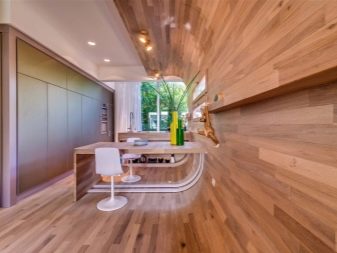
It would seem that parquet board is ideal for kitchen cladding. However, it has some disadvantages that should be taken into account. The main disadvantage is the high risks of purchasing low-quality products. They are susceptible to sudden temperature changes or high humidity. As a result of such influences, the material can deform, spoiling the "overall picture". Another drawback is the high cost. According to those who are professionally engaged in cosmetic repairs, parquet board is not the best cladding.


Lining
This material is suitable for any interiors and types of kitchens due to the variety of design solutions. Previously, the lining was made only of wood. The modern market offers a wider selection of materials. Depending on personal preferences and financial capabilities, you can purchase lining from:
- wood;
- MDF;
- plastic (PVC products).
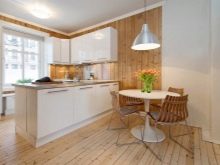


Regardless of the material of manufacture, the lining is produced in the form of long narrow sheathing strips. Installation of such products is carried out by means of the “thorn-groove” system.
Lining made of natural wood is used less often in kitchen interiors than other types of it. This is primarily due to the high cost of cladding and some other disadvantages. These include fire hazard, poor resistance to high humidity, poor design. Basically, the owners of private log houses who want to emphasize the stylistic unity of the external and internal finishing of the building tend to her choice.


More often, for wall cladding, lining made of MDF and PVC is used. These products boast a variety of textures and colors. They are cheaper than natural wood material, but they have great advantages. For example, they are not afraid of moisture, have high hygiene, unpretentious care, resistance to aggressive compounds.


Drywall
The material is rarely used. Basically, it is chosen by those who want to disguise too noticeable irregularities in the walls or hide engineering communications. It is worth noting that plasterboard cladding is not suitable for kitchens in Soviet homes. In "Khrushchevs" the square of this room is minimal. It ranges from 5 to 7 meters. In turn, plasterboard cladding implies a decrease in the usable area of space, therefore, its use in small-sized rooms is impractical.

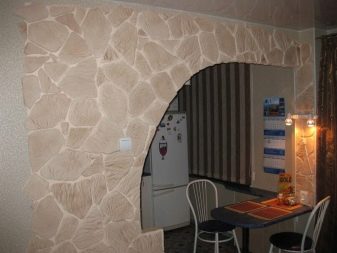
In addition to cladding, drywall is used for a variety of architectural forms. It is suitable for creating structures with both simple and complex configurations. The use of this material in the interior is due to a number of advantages.
- Easy to install. It is allowed to mount sheets both on a special adhesive composition and on a pre-erected frame base. The first method is suitable if the wall surfaces have embossed external flaws. The second is relevant for walls with small visual errors.
- Fire safety. Most materials are impregnated with anti-flammable compounds.
- Environmental friendliness. During operation, the casing does not emit substances harmful to human health into the environment.


In addition, the plus includes a wide selection of materials for finishing. Wallpaper is glued to drywall, covered with coloring compounds, decorative plaster is applied, decorative tiles or mosaics are installed.

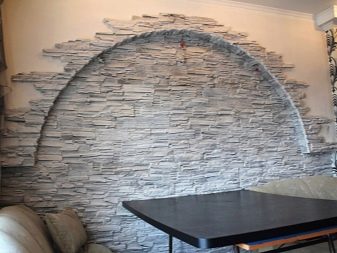
Facing with stone and tiles
The use of natural or artificial stone is an original and non-standard way to decorate a kitchen. These materials can transform a nondescript space into a cozy and luxurious space. The kitchen decorated with stone will emphasize the high status of the owners and their excellent taste. Such cladding is chosen not only for its aesthetics. The following qualities are a priority.
- Durability - the finish can serve for more than one decade without losing its original qualities.
- Ecological cleanliness - the material is absolutely safe for the health of children and adults.
- Wide range of designs. By choosing a decorative stone, you can get a smooth, embossed, matte, shiny or rough surface.
- Simple installation. The stone is glued to a special solution or plaster. For finishing, piece products, panels (produced in the form of plates, strips or sheets) are suitable.
- Unpretentiousness - such a cladding helps to repel dust, so that it does not require frequent maintenance.
- Resisting the fire.
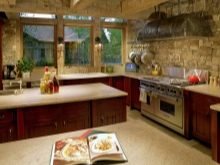


It would seem that this is the ideal material for use in the kitchen, but it is not. Stone coverings are very expensive, especially for materials made by nature itself. In addition, some types of stone fade over time with frequent and prolonged exposure to sunlight.


An alternative to stone cladding is ceramic tiles. It has many of the benefits of a stone. These include durability, moisture resistance, fire safety, environmental friendliness, unpretentious care and aesthetics. Unlike stone, tiles are much cheaper. The material has no significant drawbacks. Its only drawback is considered to be the "fear" of cleaning agents with abrasive particles. When using powders, there is a high risk of tarnishing the surface or the formation of scratches, abrasions.


The tile is produced in different standard sizes in a variety of design and color versions, due to which it is not difficult to choose a product that is suitable in appearance. To create an original interior, designers advise combining this cladding with other types of finishes. For example, a practical solution would be to decorate the wall of the kitchen working area with hog tiles, and other walls with decorative plaster or MDF panels.
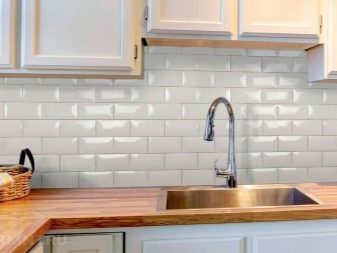

Other types of finishing materials
There are several more varieties of finishes designed for redecorating a kitchen. Let's take a look at some of them.
- Decorative plaster. It is a ready-to-use compound intended for application to walls. The main purpose of this material is to hide surface defects and create an original style in the interior. The coating has water-repellent properties, it can withstand significant temperature fluctuations, high humidity. The disadvantages of plaster include its high cost and complexity of application - without knowledge and skills, it will not work to cover the walls beautifully.
Hiring professional repairmen will incur additional financial costs.


- Decorative brick. One of the best materials for decorating a loft-style room. They trim both the walls of the kitchen and the apron of the headset. Textured cladding goes well with furnishings and household appliances. The brick does not support combustion and does not ignite, it is easy to maintain and does not change its appearance when exposed to moisture, high temperatures, acid and alkaline solutions.

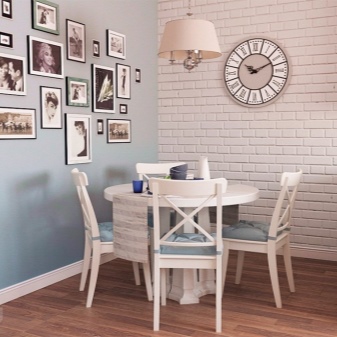
- Mosaic. The material is represented by small square-shaped items made of ceramics or glass. This material is more expensive than conventional ceramic tiles. Another disadvantage is the lengthy installation process. Laying a mosaic is a painstaking job that requires diligence and patience to complete.


- Often, paints are used to decorate the walls. Most often, preference is given to acrylic options. Before applying them, a filler is applied to the wall for leveling, after which the surface is primed. After drying, the coloring composition is applied. With the help of paints, you can quickly and easily design a space effectively in any of your preferred styles.


Modern combination ideas
The combination of several types of materials for wall decoration is an excellent opportunity to make a room original. Having resorted to this design technique, it is easy to visually divide the space into a dining area and a work area.


When decorating a working wall, you need to select materials that are fire-resistant, moisture-repellent and unpretentious in cleaning. These include tiles, mosaics, plastic panels, PVC clapboard, brick or stone. Photo wallpaper, vinyl or non-woven fabrics are perfectly combined with these materials. In addition, painting "non-working" walls with acrylic compound would be a good solution.


Selection Tips
To find the most suitable material for finishing your kitchen, it is important to heed some of the recommendations.
- For a private house, a "natural" finish of natural origin with a textured surface is best suited. Such cladding includes stone or wood.
- Washable wallpapers, wall panels, tiles are perfect for decorating walls in an apartment.
- If you plan to make repairs in a small kitchen, you should abandon finishing materials in dark colors. Visually, they will reduce the already small space.
- The following types of cladding are not suitable for finishing "Khrushchev": lining, wall panels, tiles (if they plan to overlay all 4 kitchen walls), brick. They will "steal" space where, due to a small square, every centimeter of the area is important.




When choosing a finish for kitchen walls, you should pay special attention to its design and palette. In appearance, it should be combined with a headset, interior items or household appliances. It is important that the space is harmonious.
In order to avoid design mistakes and make your kitchen truly stylish and luxurious, you can take a closer look at the ready-made design projects in advance.


Beautiful design examples
The choice of aesthetic “clothes” for kitchen walls does not guarantee a perfect result. To make the interior of the room original and elegant, you should be creative at the planning stage. A kitchen can be made stylish by combining bright and delicate light colors, by trying to create accents by playing on contrasts, or by combining 2 different types of cladding. We recommend that you look at beautiful examples of design and take your favorite ones into service.


- Contrast wall combined with snow-white furnishings... This example clearly illustrates how small kitchens can be decorated with advantage. On the project, the premises are decorated in a Scandinavian style. In this case, the white color of the furniture will create a feeling of comfort, and the bright floral ornament of the walls will add charm and charm.

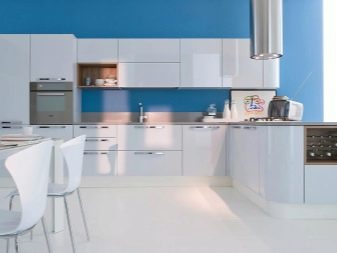
- The second example shows how to focus on one of the walls.... In this case, the surface near the dining area is framed. The textured wall is finished with natural stone, photo wallpaper is used. This option is suitable for wealthy owners.

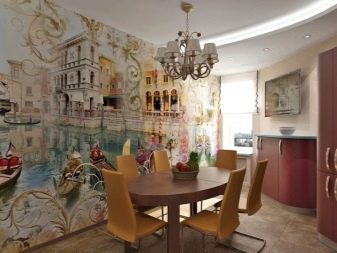
- The third option is one of the simplest and most budgetary... For example, a minimalist kitchen. It is suitable for those who are used to living simply, but with taste. In the photo, the walls are painted with blue acrylic paint, photo wallpaper is used. This example clearly shows the successful combination of cold and warm colors.


Through the manifestation of creativity, you can try to create your own design project. An abundance of types of finishing materials, their textures and colors will help to realize any ideas and author's projects, regardless of their complexity.
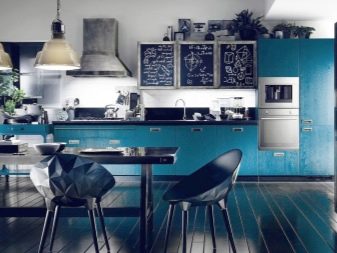


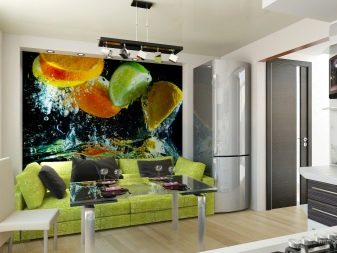
For a video review of kitchen finishes, see the video below.













The comment was sent successfully.